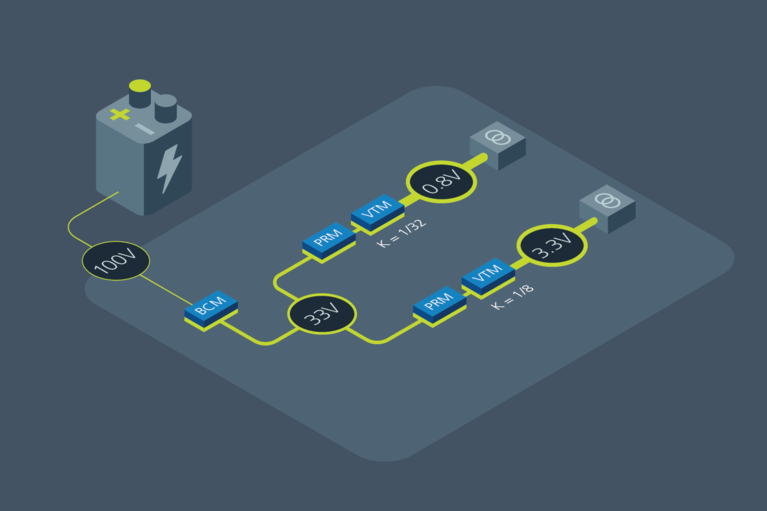
使用 MOSA、SOSA 和 VPX 开放式架构的未来标准化防御平台
使用 MOSA、SOSA 和 VPX 开放式架构的未来标准化防御平台
尊敬的用户:
为了改进 Vicor 网站,我们将于美国东部时间 12 月 29 日上午 11:30 至下午 2:00 对网站进行维护。
在此期间,您可能无法查看网站的某些部分,特别是产品页面和产品型号列表。
对于给您带来的不便,我们深表歉意,并感谢您的耐心等待。
– Vicor 网站团队
太空是一个充满挑战且不容许任何差错的环境,要求设备具备最高性能和绝对可靠性。因此,仔细选择最适合应用的产品至关重要。对于低地球轨道(LEO)和中地球轨道(MEO)卫星而言,耐辐射部件是确保卓越性能和延长任务寿命的最佳选择。Vicor 公司成熟的耐辐射高密度电源模块性能卓越,并经过严格测试,能够承受太空环境的严苛考验。
作者:Ken Coffman,高级现场应用工程师;Salah Ben Doua,首席应用工程师
太空中的电子系统面临诸多危险,包括持续受到电磁波和粒子辐射的影响。半导体器件特别容易受到粒子辐射的影响,这可能导致混乱和系统故障。
然而,并非所有太空应用都需要相同程度的辐射防护。例如,深空探测任务使用昂贵的耐辐射强化组件,而当今的新太空应用,如运行在 LEO(低地球轨道)和 MEO(中地球轨道)的卫星,则只需要“耐辐射”的组件和电路。
如图 1 所示,电磁波辐射和粒子辐射虽然相关,但对系统的影响却有所不同。单个粒子的质量虽小,但可以加速到极高的速度。它们还可能携带电荷 —— 通常由于原子轨道中的负电荷电子被剥离而带正电荷。

图 1:辐射谱。
粒子辐射可能造成物理损坏,尤其是对半导体晶格结构的破坏,这种损伤可能是永久性的和/或累积性的。当电子被拖入耗尽区并使非导电区导电时,系统也会出现暂时性故障。
另一方面,如果正离子取代晶体矩阵中的掺杂原子,就可能造成永久性损伤,使不应导电的半导体开始导电,从而因电路故障而造成永久性损坏。
很大一部分辐射损伤是累积性的,所以任务的持续时间将始终是一个无法回避的因素。
在当今迅速发展的新太空商业环境中,发射和更换失效卫星的成本十分高昂,因此精心设计至关重要。
选择耐辐射的组件。某些半导体工艺节点改进了耐辐射性能。双极型半导体可以根据位移损伤等级进行选择,而宽带隙(GaN)场效应晶体管(FET)具有固有的耐辐射能力。某些环氧树脂和铝电解电容在真空中会释放气体,因此不适合在太空环境中使用。
考虑到不同批次之间的差异,应对多批次产品的耐辐射性能进行抽样测试。
可以采用多重冗余设计。物理冗余是一种保障措施。如果一个系统失效,另一个可以接替工作。在某些系统中,有三个并行运行的系统,如果其中一个与另外两个不一致,其输出就可以被忽略。
可以降低功率金属氧化物半导体场效应晶体管(MOSFET)的额定值,这样即使在不可避免的栅源电压(VGS)阈值降级后,器件在任务结束时仍能正常工作。
屏蔽可以保护敏感的电子设备,但如果粒子能量足够高,级联的屏蔽粒子反而可能加剧问题。
可以添加电路来监控性能,如果故障可恢复,则可以断开并重启不一致的系统。
然而,无论采用什么设计策略和电源拓扑结构,新太空电子系统都必须经过严格的分析、仿真和测试,以确保其环境和耐辐射性能。
软开关拓扑结构(相比于硬开关电源转换器)能够降低寄生效应对系统的影响,如增加开关组件的电压应力引起的振铃现象。
评估拓扑结构时需要考虑的因素包括功率密度、效率、瞬态响应、输出纹波、电磁干扰(EMI)辐射以及成本。
MOSFET 的开关损耗主要来自栅极电荷需求和漏源电容。
随着开关频率的提高,开关损耗也会增加,这就限制了开关频率的进一步提升。体二极管的导通损耗进一步降低了硬开关转换器的电源转换效率。
虽然 GaN FET 没有物理的体二极管,但它们确实有一个电压为几伏特的反向导通模式,这使得 GaN器件的死区导通期变得非常难以管理。
在同步硬开关降压拓扑中,高边 FET 在其两端电压最大时开启,并在工作周期的开通阶段导通最大电流(如图 2 左侧所示)。输入电压越高,功率损耗就越大,因此在高电压比应用中(如 28V 降至 3.3V),转换器的效率会比转换比更高的转换器(如 5V 降至 2.5V)要差。
图 2:拓扑寄生效应。传统硬开关降压转换器(左)与零电压开关(ZVS)降压转换器(右)对比。
软开关技术可以减少开关损耗。零电压开关(ZVS)技术是软开关的一种典型应用,它提高了各种电源拓扑的转换效率。ZVS 在开关电压接近零或为零时开启高边 FET(参见图 2 右侧)。
利用 ZVS 技术操作钳位开关,可以在高低边开关都关闭时,在输出电感中储存少量能量。转换器利用这部分原本会被浪费的能量来对高边 FET 的输出电容进行放电,并给同步 FET 的输出寄生电容充电。
通过消除 FET 输出电容在开关开启过程中的影响,设计人员可以不用过分关注栅极-漏极电容(Cgd),而将注意力集中在导通状态下的通道电阻上,而不是通道电阻与栅极电容的乘积等传统的性能指标。
这种在开启期间驱动高边 FET 的方法可以避免激发开关的寄生电感和电容,这些寄生参数在硬开关拓扑中往往会产生谐振,引起大幅电压尖峰和振铃(见图 3a)。通过消除尖峰和减少振铃(见图 3b),ZVS 技术不仅减少了一个功率损耗项,还消除了一个电磁干扰(EMI)源。
图 3:硬开关与软开关波形对比。
通过消除开关过程中的电压尖峰,设计人员可以选用导通电阻(RDSON)更低的低电压场效应晶体管(FET),从而提高效率。
Vicor 是众多开发软开关技术的公司之一,并将其运用于耐辐射电源模块解决方案,为中地球轨道(MEO)和低地球轨道(LEO)卫星应用的高性能通信 ASIC 供电(见图 4)。这些系统模块在 PRM™(电源调节模块)中使用零电压开关(ZVS)降压-升压拓扑结构,而在 BCM®(母线转换器模块)和 VTM™(电压转换器模块)中则同时运用了零电压开关(ZVS)和零电流开关(ZCS)正弦幅值转换器™(SAC™)技术。
图 4: 高功率谐振(零电压开关和零电流开关)拓扑模块。
电压转换模块(VTM)体积小巧,可以尽可能靠近 ASIC 放置。在满足现代 ASIC、FPGA、CPU 和 GPU 等的大电流需求时,优化配电网络(PDN)至关重要。
因此,Vicor 公司的模块结合了软开关方案、耐辐射的有源组件和车规级无源组件。
为了降低单事件功能中断的影响,所有耐辐射模块都包含完全冗余的并联动力系统。如果一个动力系统因单一事件而受到干扰,其保护电路会强制执行断电复位。在复位期间,冗余动力系统承担全部负载,复位完成后两个动力系统再次并联运行。
设计新的太空电源转换器时,选择合适的拓扑结构和开关模式也是非常重要的考虑因素,此外还有许多其他因素需要权衡。
本文最初由 New Electronics 发布。
Ken Coffman,高级现场应用工程师,被指派到 Vicor 新太空计划工作。他住在亚利桑那州凤凰城。您可以给 Ken 发邮件,邮箱地址为:kcoffman@vicr.com。
Ken Coffman,高级现场应用工程师
Salah Ben Doua,首席应用工程师,在电源设计领域拥有 30 年的丰富经验,为 Vicor 客户提供支持已有 20 余载,主要为包括航空航天与国防、工业、铁路、照明与通信在内的众多领域的 DC-DC 和 AC-DC 电源系统开发提供专业技术及咨询。Salah 毕业于图卢兹国家理工学院 (the National Polytechnic Institute of Toulouse),获电源转换专业博士学位。
Salah Ben Doua,首席应用工程师
使用 MOSA、SOSA 和 VPX 开放式架构的未来标准化防御平台
使用 MOSA、SOSA 和 VPX 开放式架构的未来标准化防御平台
为新太空应用提供更高的功率密度和低噪声
为太空通信应用提供最佳功率和低噪声所需的专利电源设计技术和架构
Spacechips 大电流处理器为在轨 AI 驱动通信供电
小型卫星亟需具备精密计算能力。了解更多低噪声、AI 赋能的电源如何推动创新应用
电流倍增器:为 AI 处理器及其他严苛应用供电的明智之选
AI 处理器需要解决低电压、高电流的严苛挑战,这将会导致电源系统设计产生瓶颈。了解 Vicor 的电流倍增技术如何改变这一现状








